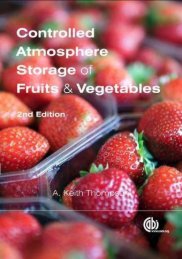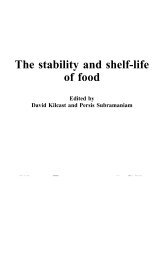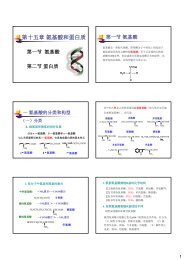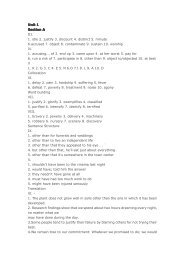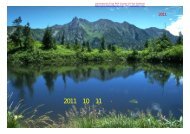Experimental investigation into the cushioning properties of ...
Experimental investigation into the cushioning properties of ...
Experimental investigation into the cushioning properties of ...
You also want an ePaper? Increase the reach of your titles
YUMPU automatically turns print PDFs into web optimized ePapers that Google loves.
Packaging Technologyand Sciencewhere e is <strong>the</strong> compressive strain <strong>of</strong> honeycombpaperboard; s is <strong>the</strong> compressive stress <strong>of</strong> honeycombpaperboard; and E is <strong>the</strong> deformation energyper unit volume, where compressive strain is e.With rapid changes <strong>of</strong> market requirements andescalating competition, honeycomb paperboardmanufacturers frequently and swiftly need toupdate <strong>the</strong>ir <strong>cushioning</strong> pad structure to meet<strong>the</strong> low-cost demands <strong>of</strong> industrial packaging.However, manufacturers always provide acommon honeycomb paperboard structure to <strong>the</strong>irclients, not because <strong>of</strong> <strong>the</strong>ir production capacity,but because <strong>of</strong> a lack <strong>of</strong> basic knowledge <strong>of</strong> material<strong>cushioning</strong> <strong>properties</strong>. This work is intendedto assist a packaging designer to produce a honeycombpaperboard pad design that represents <strong>the</strong>lowest cost for clients.The main aim <strong>of</strong> this paper is to research <strong>the</strong>effect honeycomb paperboard structures, relativedensity <strong>of</strong> paper honeycomb cores, liners andlayouts <strong>of</strong> <strong>cushioning</strong> pads have on <strong>cushioning</strong><strong>properties</strong>. A fur<strong>the</strong>r objective is to establish abasic and fundamental knowledge <strong>of</strong> <strong>cushioning</strong><strong>properties</strong> <strong>of</strong> honeycomb paperboards.EXPERIMENTAL METHODSD.-M. WANG AND Z.-W. WANGSamples <strong>of</strong> different heights (10, 20, 30, 40 and50 mm), different kraft liners (250, 300, 350 g/m 2basis weights), different basis weights <strong>of</strong> <strong>the</strong> honeycombcell-walls (112, 127, 150,180 g/m 2 ; <strong>the</strong> correspondingthickness <strong>of</strong> <strong>the</strong> honeycomb cell-wallswere 0.20, 0.22, 0.25, 0.29 mm, respectively) anddifferent honeycomb cell types (A, B, C and D; <strong>the</strong>lengths <strong>of</strong> <strong>the</strong> honeycomb cell-walls were 5.8, 8.7,12.1, 14.4 mm, respectively) were made.The experiments were conducted at <strong>the</strong>Shenzhen Control and Test Centre for PackagingQuality and Packaging Test Centre <strong>of</strong> ShenzhenPolytechnic. The test equipment included a KBFtest chamber for constant temperature and constanthumidity (manufactured by Binder Company,Tuttlingen, Germany) condition, and a CMT universalmaterial tester from SANS Company (locatedin Shenzhen, China). The reference test standardsinclude Testing Method <strong>of</strong> Static Compression forPackage Cushioning Materials GB8168–87; 7 PolymericMaterials, Cellular Flexible – Determination <strong>of</strong> StressstrainCharacteristics in Compression – Part 1: LowdensityMaterials ISO 3386/1; 8 Packaging – TransportPackages – Temperature and Humidity ConditioningISO 2233–1986; 9 and Paper, Board and Pulps – StandardAtmosphere for Conditioning and Testing ISO187:1990. 10All test samples were approximately 200 ×200 mm 2 . The tests were conducted in an environment<strong>of</strong> 23 ± 1°C, 50 ± 2% relative humidity, andunder a constant displacement velocity <strong>of</strong> 12 ±2 mm/min. Every compression test was effectivelyconducted in five repeats, and <strong>the</strong> mean value calculatedfrom <strong>the</strong> five test values is shown in <strong>the</strong>stress–strain curves <strong>of</strong> Figures 2, 3, 7, 9 and 11.EXPERIMENTAL SAMPLESAND RESULTSCushioning <strong>properties</strong> <strong>of</strong> paperhoneycombs with and without linersThe structure <strong>of</strong> experiment samples is shown inFigure 1. The experiment samples and characteristicsare listed in Table 1. 180B paper honeycombcore indicates <strong>the</strong> honeycomb cell is B type, and<strong>the</strong> basis weight <strong>of</strong> base paper made <strong>into</strong> paperhoneycombs is 180 g/m 2 . 450/180B/450–50 indicatesthat <strong>the</strong> basis weights <strong>of</strong> <strong>the</strong> liners bondedto 180B paper honeycomb are 450 g/m 2 and <strong>the</strong>height <strong>of</strong> paper honeycomb core is 50 mm. Figure2 shows <strong>the</strong> effect <strong>of</strong> liners on <strong>the</strong> <strong>cushioning</strong> <strong>properties</strong><strong>of</strong> honeycomb paperboard. The stress–straincurves <strong>of</strong> paper honeycomb cores with and withoutliners are similar, but <strong>the</strong> strength <strong>of</strong> <strong>the</strong> paperFigure 1. The structure sketch map <strong>of</strong> experiment samples.Copyright © 2008 John Wiley & Sons, Ltd. Packag. Technol. Sci. (2008)DOI: 10.1002/pts
INVESTIGATION INTO THE CUSHIONING PROPERTIESPackaging Technologyand ScienceTable 1. Experiment samples and characteristicsSamplesPaperhoneycombcoreLiner(g/m 2 )LinerpresentHeight(mm)180B-50 180B – No 50450/180B/450–50 180B 450 Bonded 50150B-40 150B – No 40300/150B/300-40 150B 300 Bonded 40Stress σ /MPaa0.50.450.40.350.30.250.20.150.10.050180B-50450/180B/450-500 0.1 0.2 0.3 0.4 0.5 0.6 0.7 0.8 0.9 1Strain εStress σ /MPaStrain ε(a) 180 B-50 (b) 150 B-40b0.50.40.30.20.1300/150B/300-40150B-4000 0.1 0.2 0.3 0.4 0.5 0.6 0.7 0.8 0.9 1Figure 2. Comparison <strong>of</strong> paper honeycombs with and without liners.honeycomb core with liners is significantly largerthan that <strong>of</strong> without liners. However, a recentpaper 11 shows that <strong>the</strong> compressive strength <strong>of</strong>metallic honeycomb with and without liners typicallydoes not change. It can be concluded that <strong>the</strong>effect <strong>of</strong> liners on <strong>the</strong> compressive strength <strong>of</strong> honeycombpaperboard must be taken <strong>into</strong> considerationand that <strong>of</strong> metallic honeycomb can be ignored.This is because <strong>the</strong> restrictions <strong>of</strong> liners on paperhoneycombs play an important role in <strong>the</strong> buckling<strong>of</strong> <strong>the</strong> paper honeycombs.Cushioning property comparison forhoneycomb paperboard withdifferent densitiesThe relative density <strong>of</strong> paper honeycomb cores isdetermined by honeycomb structure factors, e.g.thickness and length <strong>of</strong> cell-wall and drawingangle. The relative density 12 <strong>of</strong> hexagonal paperhoneycombs isρc= ⎛ tρ ⎝ ⎞ 1 + hl(2)⎠s l ( hl+sinθ)cosθwhere r c is <strong>the</strong> density <strong>of</strong> paper honeycomb cores;r s is <strong>the</strong> density <strong>of</strong> base paper made <strong>into</strong> paperhoneycombs; t is <strong>the</strong> thickness <strong>of</strong> <strong>the</strong> base papermade <strong>into</strong> paper honeycombs; l is <strong>the</strong> length <strong>of</strong> <strong>the</strong>single-cell-wall <strong>of</strong> hexagonal honeycomb; h is <strong>the</strong>length <strong>of</strong> <strong>the</strong> double-cell-wall <strong>of</strong> hexagonal honeycomb;and q is <strong>the</strong> drawing angle <strong>of</strong> paper honeycombcores, here, q = 30°.The experimental samples and <strong>the</strong>ir characteristicsare listed in Table 2. The experimental resultsare shown in Figure 3. Figure 3 illustrates thatrelative density has a significant effect on <strong>cushioning</strong><strong>properties</strong>. With <strong>the</strong> increase <strong>of</strong> relative density,<strong>the</strong> compressive stress significantly increases.Therefore, when optimizing honeycomb paperboardstructures, we can increase <strong>the</strong> relativedensity <strong>of</strong> paper honeycomb cores; however, thisincreases costs.Copyright © 2008 John Wiley & Sons, Ltd. Packag. Technol. Sci. (2008)DOI: 10.1002/pts
Packaging Technologyand ScienceD.-M. WANG AND Z.-W. WANGTable 2. Experiment samples and characteristicsSamplesRelativedensityr c /r sHoneycombcoreHeight(mm)Liner(g/m 2 )Energyper unitvolume E(N/m 2 )Density(kg/m 3 )250/150A/250 0.066 150A 20 250 0.1619 64.6350/180B/350 0.051 180B 20 350 0.1154 66.6250/150B/250 0.044 150B 20 250 0.0929 51.4250/150C/250 0.032 150C 20 250 0.0637 44.2350/150D/350 0.026 150D 20 350 0.0523 50.6Stress σ /MPa0.40.320.240.160.08250/150A/250350/150B/350350/150C/350250/150D/250250/180B/25000 0.1 0.2 0.3 0.4 0.5 0.6 0.7 0.8 0.9 1Strain εFigure 3. Effect <strong>of</strong> relative density <strong>of</strong> paper honeycombcores on <strong>the</strong> <strong>cushioning</strong> <strong>properties</strong> <strong>of</strong> honeycombpaperboards.Energy abosorption perunit volume E/N/m 20.180.160.140.120.10.080.060.040.0200.02 0.03 0.04 0.05 0.06 0.07Relative density r c /r sFigure 4. Relationship between <strong>the</strong> maximum deformationenergy per unit volume and <strong>the</strong> relative density <strong>of</strong> paperhoneycomb cores.Research on <strong>cushioning</strong> <strong>properties</strong> <strong>of</strong> paper honeycombcores with different relative density isimportant to reduce cost. The relationship betweenmaximum deformation energy per unit volumeand relative density <strong>of</strong> paper honeycomb cores isshown in Figure 4.A fur<strong>the</strong>r research is to determine <strong>the</strong> relationshipbetween <strong>the</strong> maximum deformation energyper unit volume and <strong>the</strong> density <strong>of</strong> honeycombpaperboard, which can directly evaluate <strong>the</strong> <strong>cushioning</strong>cost. The density r <strong>of</strong> honeycomb paperboardcan be written aswhere r is <strong>the</strong> density <strong>of</strong> honeycomb paperboard;r f is <strong>the</strong> basis weight <strong>of</strong> liner; S is <strong>the</strong> load area,here, S is 7850 mm; 2 H is <strong>the</strong> height <strong>of</strong> paperhoneycomb core; and t 1 is <strong>the</strong> thickness <strong>of</strong> <strong>the</strong>liner – here, t 1 is enough less than H, so we <strong>of</strong>tenignore t 1 in Equation 3.r s can be described by basis weight r ss <strong>of</strong> <strong>the</strong> basepaper for paper honeycombs asρ = ρ t (4)sssFrom Equations 3 and 4, we obtainρρ + ⎛ ρ + ρ⎝ ⎜ c ⎞2 fρ ⎠⎟ ρ sH2 fScSHsρ ==St+H t + H( )1 1(3)ρ =ρρ + ⎛ ⎝ ⎜ ⎞ρ ⎠⎟ ρsH2 fcssHt(5)Copyright © 2008 John Wiley & Sons, Ltd. Packag. Technol. Sci. (2008)DOI: 10.1002/pts
INVESTIGATION INTO THE CUSHIONING PROPERTIESPackaging Technologyand ScienceAccording to Figure 2, <strong>the</strong> relationship between<strong>the</strong> maximum deformation energy per unit volumeand <strong>the</strong> density <strong>of</strong> honeycomb paperboard isshown in Figure 5.Figures 4 and 5 show that <strong>the</strong> relative density <strong>of</strong>paper honeycomb cores has a significant effect on<strong>the</strong> maximum energy absorption <strong>of</strong> honeycombpaperboards. With <strong>the</strong> increase <strong>of</strong> <strong>the</strong> relativedensity, <strong>the</strong> maximum energy absorption increases.However, <strong>the</strong>re is no direct relation between <strong>the</strong>max deformation energy per unit volume and<strong>the</strong> density <strong>of</strong> honeycomb paperboard. In fact, <strong>the</strong>basis weight <strong>of</strong> <strong>the</strong> liners has a significant effect on<strong>the</strong> stiffness <strong>of</strong> honeycomb paperboard. Therefore,we can improve <strong>the</strong> <strong>cushioning</strong> property <strong>of</strong>honeycomb paperboard by increasing <strong>the</strong> relativedensity <strong>of</strong> paper honeycomb core, and improve <strong>the</strong>stiffness by increasing <strong>the</strong> basis weight <strong>of</strong> liners.Cushioning property <strong>of</strong> multilayerhoneycomb paperboardThe experimental samples and <strong>the</strong>ir characteristicsare listed in Table 3. The mode <strong>of</strong> <strong>the</strong> compressiveEnergy abosorption perunit volume E/N/m 20.180.160.140.120.10.080.060.040.02040 50 60 70 80Density <strong>of</strong> honeycomb paperboard r/kg/m 3Figure 5. Relationship between <strong>the</strong> maximum deformationenergy per unit volume and <strong>the</strong> density <strong>of</strong> honeycombpaperboard.load is shown in Figure 6. The <strong>cushioning</strong> <strong>properties</strong><strong>of</strong> multilayer honeycomb paperboard agreewith <strong>the</strong> stack <strong>the</strong>ory, 13 and <strong>the</strong> strain e <strong>of</strong> multilayer<strong>cushioning</strong> materials isε = αε 1 + βε 2 (6)where e is <strong>the</strong> strain <strong>of</strong> multilayer honeycombpaperboard; e 1 , e 2 is <strong>the</strong> strain <strong>of</strong> two monolayerhoneycomb paperboards; and a, b is <strong>the</strong> thicknessproportion <strong>of</strong> two monolayer honeycomb paperboardin total thickness.Figures 7 and 8 show <strong>the</strong> difference betweenmultilayer and monolayer honeycomb paperboards.During compression on multilayer honeycombpaperboards, <strong>the</strong> one with <strong>the</strong> lower strengthis always crushed first, and <strong>the</strong>n <strong>the</strong> o<strong>the</strong>r. Thestrength <strong>of</strong> <strong>the</strong> 10 + 10 mm multilayer is significantlylarger than <strong>the</strong> 20 mm monolayer; however,<strong>the</strong> strength <strong>of</strong> <strong>the</strong> 20 + 10 mm multilayer is partlylower than <strong>the</strong> 30 mm monolayer, even though <strong>the</strong>20 + 10 mm multilayer possesses two additionalliners. In energy absorption, <strong>the</strong> deformationenergy <strong>of</strong> <strong>the</strong> 20 + 10 mm multilayer is also lowerthan <strong>the</strong> 30 mm monolayer honeycomb paperboard.Therefore, <strong>the</strong> <strong>cushioning</strong> and energyabsorption <strong>properties</strong> <strong>of</strong> multilayers are not alwayshigher than monolayer honeycomb paperboards<strong>of</strong> <strong>the</strong> same total thickness. It must be noted that<strong>the</strong> compressive stress–strain <strong>of</strong> <strong>the</strong> 20 + 10 mmmultilayer has a second peak, which can withstandsecond impacts.aFigure 6. Load and stack confi guration <strong>of</strong> honeycombpaperboard. (a) multilayer; (b) monolayer.bTable 3. Experiment samples and characteristicsSamples Paper honeycomb core Liner (g/m 2 ) Height (mm)250/127B/250-30 127B 250 30250/127B/250-20 127B 250 20250/127B/250-10 127B 250 10Copyright © 2008 John Wiley & Sons, Ltd. Packag. Technol. Sci. (2008)DOI: 10.1002/pts
Packaging Technologyand ScienceStress σ/MPaa0.30.250.20.150.10.05010mm+10mm20mm0 0.2 0.4 0.6 0.8Strain εStress σ/MPab0.40.320.240.160.0800 0.2 0.4 0.6 0.8D.-M. WANG AND Z.-W. WANGStrain ε20mm+10mm30mm10mm20mmFigure 7. Comparison <strong>of</strong> multilayer and monolayer honeycombpaperboard. (a) 10 ± 10 mm stack; (b) 10 ± 20 mm stack.Energy absorption per unit volumeE /(N/m2)0.140.120.10.080.060.040.02010 20 10+10 20+10 30Height <strong>of</strong> honeycomb paperboard H/mmFigure 8. Energy absorption histogram <strong>of</strong> multilayer andmonolayer honeycomb paperboards.Cushioning <strong>properties</strong> <strong>of</strong> honeycombpaperboards with different heightsThe experimental honeycomb paperboards havedifferent heights (10, 20, 30 and 50 mm, respectively)and with <strong>the</strong> same 127B paper honeycombcore and 350 g/m 2 liner. The compressive stress–strain curves are shown in Figure 9.The 30 mm height honeycomb paperboard has ahigh critical stress; <strong>the</strong> 10 mm height honeycombpaperboard has a high plateau stress; and <strong>the</strong>20 mm height honeycomb paperboard has <strong>the</strong>lowest <strong>cushioning</strong> ability. From <strong>the</strong>ory, <strong>the</strong> ratio <strong>of</strong><strong>the</strong> height <strong>of</strong> honeycomb paperboard to length <strong>of</strong>honeycomb cell-wall has an effect on its <strong>cushioning</strong><strong>properties</strong> when <strong>the</strong> ratio is less than four. 14The above results agree with this <strong>the</strong>ory 14 anddynamic compression test results from <strong>the</strong> document.3 Therefore, properly selecting <strong>the</strong> height isvery important to improve <strong>the</strong> <strong>properties</strong> <strong>of</strong> honeycombpaperboard.Cushioning <strong>properties</strong> <strong>of</strong> honeycombpaperboard with differentcompressive directionsThe three load directions <strong>of</strong> honeycomb paperboardare shown in Figure 10. The 150B paperhoneycomb core with 50 mm height bonded toliners was used in <strong>the</strong> experiment. The compressivestress-strain curve is given as Figure 11.The three orientation compression results showthat <strong>the</strong> flat compressive stress is significantlyhigher than <strong>the</strong> side and vertical compressivestress, and <strong>the</strong> side and vertical orientation energyabsorptions are similar and smaller.CONCLUSIONSMany experiments were conducted to investigate<strong>the</strong> <strong>cushioning</strong> <strong>properties</strong> <strong>of</strong> honeycomb paperboard.The liners, density, height <strong>of</strong> honeycombpaperboard, multilayer honeycomb paperboardand compressive orientations have been discussedin detail.The stress–strain curves <strong>of</strong> honeycomb coreswith and without liners are similar, but <strong>the</strong> strengthand energy absorption <strong>of</strong> paper honeycombs withliners is significantly larger than those <strong>of</strong> withoutliners.Copyright © 2008 John Wiley & Sons, Ltd. Packag. Technol. Sci. (2008)DOI: 10.1002/pts
INVESTIGATION INTO THE CUSHIONING PROPERTIESPackaging Technologyand ScienceStress σ/MPa0.30.250.20.150.10.0500 0.2 0.4 0.6 0.8 1Strain εH=50H=30H=20H=10Figure 9. Stress–strain curves <strong>of</strong> honeycomb paperboards with differen<strong>the</strong>ights.flat0.15sideverticalsideverticalStress σ/MPa0.10.05flatFigure 10. Load direction.The relative density <strong>of</strong> paper honeycomb coreshas a larger effect on <strong>the</strong> <strong>cushioning</strong> property <strong>of</strong>honeycomb paperboard. Changing <strong>the</strong> structure orincreasing <strong>the</strong> relative density <strong>of</strong> paper honeycombscan improve <strong>the</strong> <strong>cushioning</strong> <strong>properties</strong>.However, <strong>the</strong> basis weight <strong>of</strong> <strong>the</strong> liners has littleeffect on <strong>the</strong> <strong>cushioning</strong> <strong>properties</strong> <strong>of</strong> honeycombpaperboards.The energy absorption <strong>of</strong> <strong>the</strong> multilayer honeycombpaperboard is not always higher than <strong>the</strong>monolayer honeycomb paperboards, although itpossesses two additional liners.The height <strong>of</strong> honeycomb paperboard has aneffect on its <strong>cushioning</strong> <strong>properties</strong>; <strong>the</strong>refore, properlyselecting its height is beneficial to optimizing<strong>properties</strong>.The flat compressive stress is significantly higherthan <strong>the</strong> side and vertical, and <strong>the</strong> side and verticalorientation energy absorptions are similar andsmaller.00 0.1 0.2 0.3 0.4 0.5Strain εFigure 11. Three orientation compressions <strong>of</strong> 50 mmhoneycomb paperboard.ACKNOWLEDGEMENTSThe authors are grateful to Dr Wang Wenming <strong>of</strong>Helisheng (Guangzhou) Paper Products Company andgeneral manager Wang Shangduan <strong>of</strong> Jinglong PaperHoneycomb Products Company for <strong>the</strong>ir help in <strong>the</strong>experiments.REFERENCES1. Wang M. The research <strong>of</strong> <strong>the</strong> honeycomb fibreboard<strong>cushioning</strong> performance and <strong>the</strong> application. Packag.Eng. 2000; 21(4): 5–9 (in Chinese).2. Zhang GM. Study on <strong>the</strong> buffering property <strong>of</strong> <strong>the</strong>honeycomb board. Packag. Eng. 2001; 22(5): 7–9 (inChinese).Copyright © 2008 John Wiley & Sons, Ltd. Packag. Technol. Sci. (2008)DOI: 10.1002/pts
Packaging Technologyand Science3. Guo YF, Zhang JH. Shock absorbing characteristicsand vibration transmissibility <strong>of</strong> honeycomb paperboard.Shock Vib. 2004; 11(5): 521–531.4. Sek M, Rouillard V. High-speed videographic study<strong>of</strong> engineered composite paperboard <strong>cushioning</strong>systems. Proceedings <strong>of</strong> <strong>the</strong> 15th IAPRI World Conferenceon Packaging. Tokyo, Japan, 2006; 258–262.5. Sek M, Rouillard V. Behaviour <strong>of</strong> multilayeredcorrugated paperboard <strong>cushioning</strong> systems underimpact loads. Appl. Mech. Mater. 2005; 3–4: 383–388.6. Miltz J, Gruenbaum G. Evaluation <strong>of</strong> cushion <strong>properties</strong><strong>of</strong> plastic foams compressive measurements.Polym. Eng. Sci. 1981; 21(15): 1010–1014.7. GB 8168. Testing Method <strong>of</strong> Static Compression forPackage Cushioning Materials. China, 1987 (inChinese).8. ISO 3386/1. Polymeric Materials, Cellular Flexible – Determination<strong>of</strong> Stress–strain Characteristics in Compression– Part 1: Low-density Materials. 1986.D.-M. WANG AND Z.-W. WANG9. ISO 2233. Packaging – Transport Packages – Temperatureand Humidity Conditioning. 1986.10. ISO 187. Paper, Board and Pulps – Standard Atmospherefor Conditioning and Testing. 1990.11. Ĉoté F, Deshpande VS, Fleck NA, Evans AG.The out-<strong>of</strong>-plane compressive behaviour <strong>of</strong> metallichoneycombs. Mater. Sci. Eng. 2004; A380: 272–280.12. Gibson LJ, Ashby MF. Cellular Solids: Structure andProperties, 2nd edn. Cambridge University Press:Cambridge, UK; 1997.13. Peng GX. Transport Package. Printing Industry Press:Beijing; China 1999 (in Chinese).14. Yang YH. Master Thesis <strong>of</strong> Sou<strong>the</strong>rn Yangtze University.Study <strong>of</strong> Environmental Protection PackagingMaterials for Transportation. Wuxi; China 2003:45–49 (in Chinese).Copyright © 2008 John Wiley & Sons, Ltd. Packag. Technol. Sci. (2008)DOI: 10.1002/pts



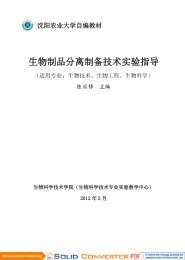

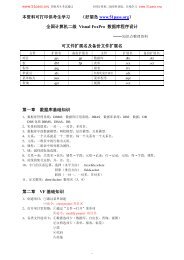
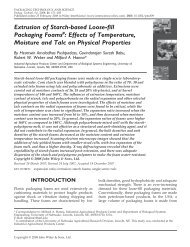
![()] 1](https://img.yumpu.com/45117883/1/190x143/-1.jpg?quality=85)
